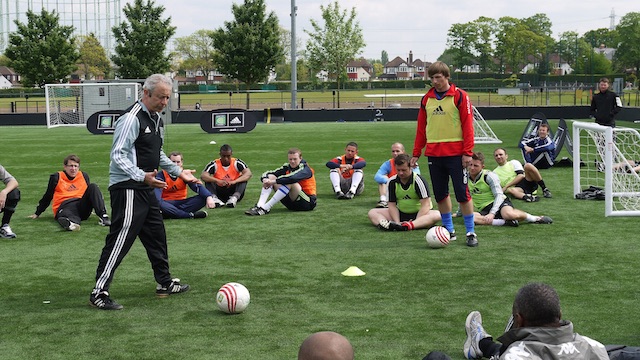The High Cost of American Coaching

The U.S. is choked with soccer players, its tournament fields overflowing on weekends and floodlit weeknights. It has long been one of the most popular games for young players in the U.S., whatever its popularity as a professional sport, and its prevalence continues to rise.
In fact, according to Statista, there have never been more soccer players in this country than there are right now. Between 2009 and 2015, the site claims the game has added about 3 1/2 million players to its total. We are, for the first time, nearing the 15 million player threshold.
The coaching apparatus in this country is desperately trying to keep up with the boom. And it has not done a particularly good job.
According to figures provided to TDS by U.S. Soccer, there are currently about 5,000 coaches in the U.S. who’ve completed the National B course, and 2,500 who’ve earned the National A course split between the Senior Course (geared toward becoming a pro coach) and the Youth Course (geared toward becoming a youth coach). The F License, which was launched in February 2015 as an introduction, has meted out about 43,000 certificates in the last 16 months.
The A and B courses are arguably the two most crucial in the coaching oeuvre. The F-C courses largely focus on foundational soccer coaching, and the recently established Pro course – it’s so new it has yet to produce a graduate – is upper level theory. The B and A courses are the real meat. B focuses on the principles of long-term player development and developing a team, while the A course dovetails into specialization. Either development of elite youth players as a part of the pathway to becoming a professional player, or development of the pro player himself.
For the sake of round numbers, let’s say there are 14 million soccer players in this country. That means there’s one B licensed coach for every 3,000 players, and one A licensed coach for every 6,000. Even the F licensed coaches, a course that takes all of two hours to complete and only takes coaches through the most basic of basics, would only stretch to about 350 players per coach.
In the same way we have a scouting crisis in this country, we have far too few educated coaches in the U.S.
U.S. Soccer’s licensing course is not the end-all of coaching education. U.S. Club Soccer offers its own La Liga-sponsored methodology courses among others, and US Youth Soccer offers its own licensing courses that are worthwhile on their own. And there are other paths to intellectual coaching solvency you can’t necessarily learn through these courses. Life is a hell of a teacher on its own.
But those who would not require any sort of formal training are few and rare and not worth using as examples. While we wait for the youngest generations among us – the ones that’ve grown up inside the global soccer exchange of ideas for the first time – we need more formally trained coaches. You can’t truly mold your training to your own personality and come into your own until you have that training in the first place.
There is an old maxim in writing that you can’t snap the rules until you know what they are. I think that holds true in coaching.
The English UEFA A course costs £4,680 (about $6,200) but only for members of the FA Licensed Coaches Club. For non-members, tack on about another $2,000 to the course fee. As of 2014, there were 1,395 UEFA A license holders in England, and since there are only 44 to a class, which are limited anyway, that number isn’t much higher today.
Compare that to Germany’s 6,934, Italy’s 2,281, France’s 3,308 and Spain’s whopping 15,423 and you see the disparity. When you line up the cost with the course, it makes sense. Germany charges less than $600 to become a UEFA A license holder. Spain’s course, too, is about $4,000 less to take than England’s.
The U.S. has largely emulated England in this, and I dare say that is not the track most of the country would have us on.
Lee Mannion, the Small Sided Games Coordinator at Manchester City, told Mark Lomas in 2013 that the steep cost of youth coaching and resulting lack of UEFA-blooded coaches has hurt the grassroots game in England. Judging by the team’s recent crash out of the Euro to an Iceland nation that charges considerably less for coaching education and by turns has significantly more UEFA accredited coaches, it’s hard to disagree.
“As much as I love grassroots football, and it is of course the heart of the English game, the lack of quality coaches and the general environment is not conducive to good development,” he says. “I coached my little brother’s Sunday League team all the way up from under-10s to under-16s and some of the things you see on a Sunday morning at the park when there are kids playing are frightening, really.
“The parents and the manager shouting at the ref, shouting at the players, compared to what the academy looks like — the parents aren’t allowed to shout, no one gives any abuse to the ref, the pitches are well-maintained. I think grassroots is still a long way from that. I’ve heard stories that kids at other academies have been let go because their dads were too abusive towards referees.”
Sound familiar?
One thing we haven’t yet discussed is cost, and this is where the relatively low numbers begin to make a kind of sense. The National B license through U.S. Soccer costs $3,000, and the A course will set you back $4,000. This has not been a palatable change for everyone.
The new US Soccer A license is $4k now. Wow. Pricing coaches out of the market. Definitely not following example of Germany, Spain, Iceland
— Joe DeMay (@JoeDeMay) June 30, 2016
Indeed not. According to FIFA, about 6 million Germans are active, registered soccer players at one level or another in the country. Their ratio for UEFA A coaches to the whole looks more like the American ratio for F licensed coaches. You are far, far more likely in Germany to run across a coach who’s been vetted at a high level, put through a national program and been allowed to find himself through the construct of education.
It is no coincidence that Spain and Germany, the respective winners of the last two Euros and last two World Cups, have the highest percentage of upper level coaches in the world. The courses are also among the cheapest.
It is no surprise, this pathway to international soccer solvency. Make the coaching courses as easy to find and cheap as possible while still offering a way for individual coaches to find themselves through a quality education. At this point in America’s soccer development, it cannot afford to price coaches out of a quality education. In truth, the U.S. needs all the help it can get.
Headlines
- Recruiting Roundup: October 6-12
- How Do I Get Scouted by TopDrawerSoccer?
-
Best of Women's College Soccer Week 8

-
Club Soccer Standouts: October 4-5

-
Best of the Week in Men's DI Soccer

-
Commitments: Texas Star Chooses Cornell

- Women's Team of the Week: Oct. 7
-
Player Rankings Spotlight: 2027 Girls

- UW Star Named Player of the Week
- Men's Top 25: Champions Back on Top



